
Collaboration styles define how individuals or groups work together, share ideas and make decisions to reach a common goal. They can be categorized by structure, function, or by individual working preferences. Understanding these styles helps teams adapt their strategies to improve communication, leverage diverse strengths, and achieve better outcomes.
Choosing the right style drives better alignment, reduces friction, and improves project outcomes. It ensures that everyone understands their role, communicates clearly, and contributes in a way that supports the team’s goals.
In this article, we discuss 12 essential collaboration styles, explain their impact on teams and tasks. You will also be shown how to pick the approach that helps your workplace collaborate with purpose and confidence.
1. Hierarchical collaboration
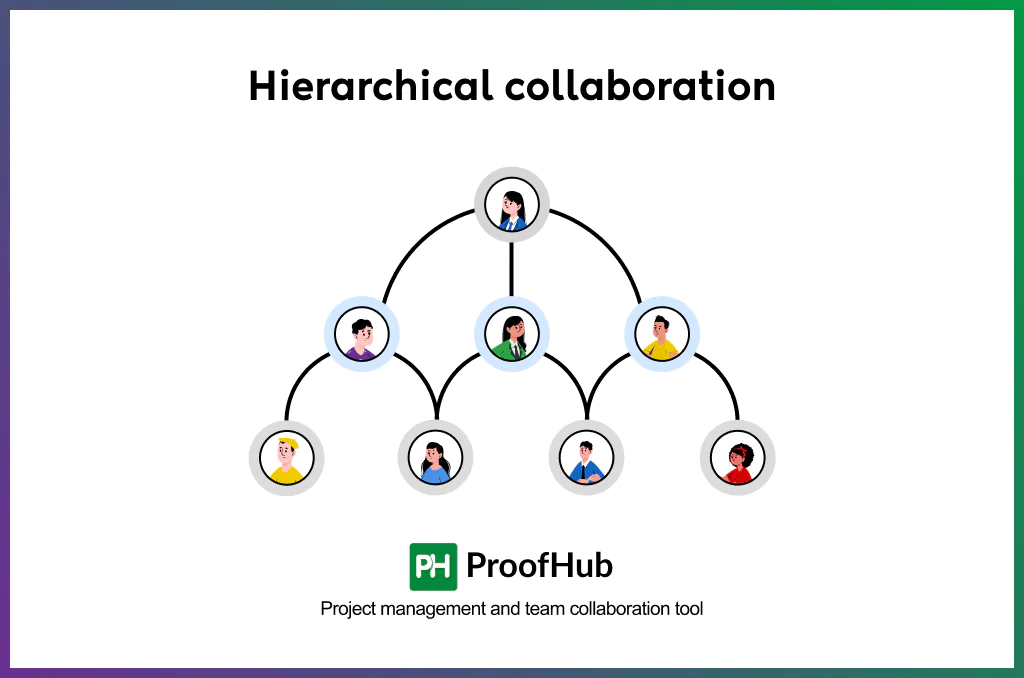
Hierarchical collaboration is a model in which the organization’s authority dictates the direction of work. In this style, communication and responsibilities follow a clear chain of command. It focuses on working under the direct supervision of managers and leaders.
Because authority and accountability are concentrated at the top, roles are clearly defined and decisions follow a predictable path. These factors tend to bring stability and control.
Let’s discuss the benefits in brief:
- Defined roles and responsibilities: Employees clearly understand who to report to and the scope of their manager’s responsibilities, creating a predictable work environment.
- Efficient communication: top-down structure ensures information flows through a clear chain of command, making it easier to share updates and reports.
- Authority and decision-making: Authority is centralized at higher levels, which can streamline decision-making in large, regulated, or risk-sensitive industries.
However, those stability-focused strengths often come at the cost of speed, innovation, and employee autonomy.
Let’s discuss the challenges in brief.
- Slow communication and decision-making: Information and approvals must pass through multiple management layers, resulting in delays, especially when quick responses are required.
- Formation of silos and limited collaboration: Hierarchical structures can create isolated departments (silos) that hinder communication and teamwork between teams. This lack of communication obstructs cross-functional problem-solving and limits the free flow of information across the organization.
- Reduced employee autonomy and engagement: Lower-level employees often have limited input in decision-making, which can leave them feeling undervalued and reduce their morale and commitment.
Hierarchical collaboration is suitable for large financial institutions, educational institutions, and large corporations.
2. Flat collaboration
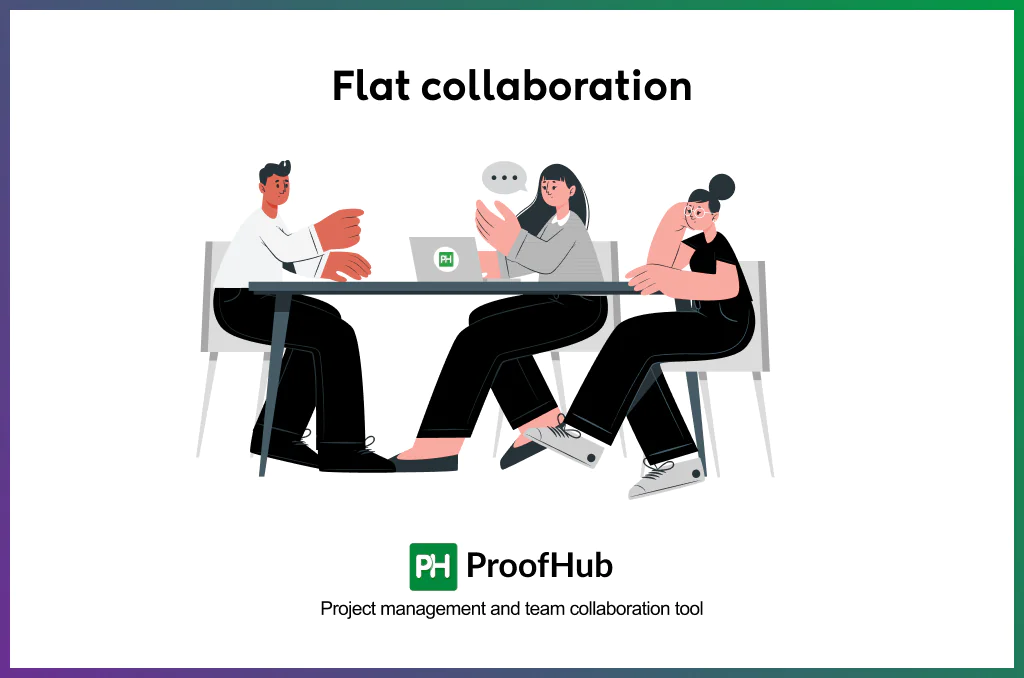
Flat collaboration is a partnership model that promotes open communication, creativity, and shared responsibility by distributing decision-making authority among participants. In this style, decisions are made through consensus by the group or by giving collaborators a voice.
The approach offers advantages such as increased agility, reduced costs, and fostering team spirit.
Let’s discuss the benefits in brief:
- Increased agility and adaptability: An organization with a flat structure is more agile and effective, which helps it respond to challenges and shifting market conditions faster.
- Decreased costs: Organizations can cut operational and overhead expenses of several levels of management by getting rid of superfluous management layers.
- Greater team spirit: A more cohesive workforce with stronger ties between teams and leadership can result from a loose hierarchy, which enhances cooperation and fosters a stronger sense of team spirit.
Yet, these qualities that make flat collaboration appealing can also create new challenges, such as creating misunderstandings, unclear responsibilities, and inconsistent processes.
Let’s discuss the challenges in brief.
- Blurred decision-making
In the absence of clear management structures, it may be challenging to determine who is responsible for making important decisions, which could lead to delays or misunderstandings.
- Uncertain roles and responsibilities: A flat organizational structure may result in employees being unclear about their precise responsibilities or who they should report to, which leads to overlaps or missed assignments.
- Inconsistent procedures: It can be challenging to uphold standards throughout the organization when management is absent because there are frequently inconsistent procedures and processes.
The flat collaboration is ideal for startups and small businesses.
3. Peer-to-peer collaboration
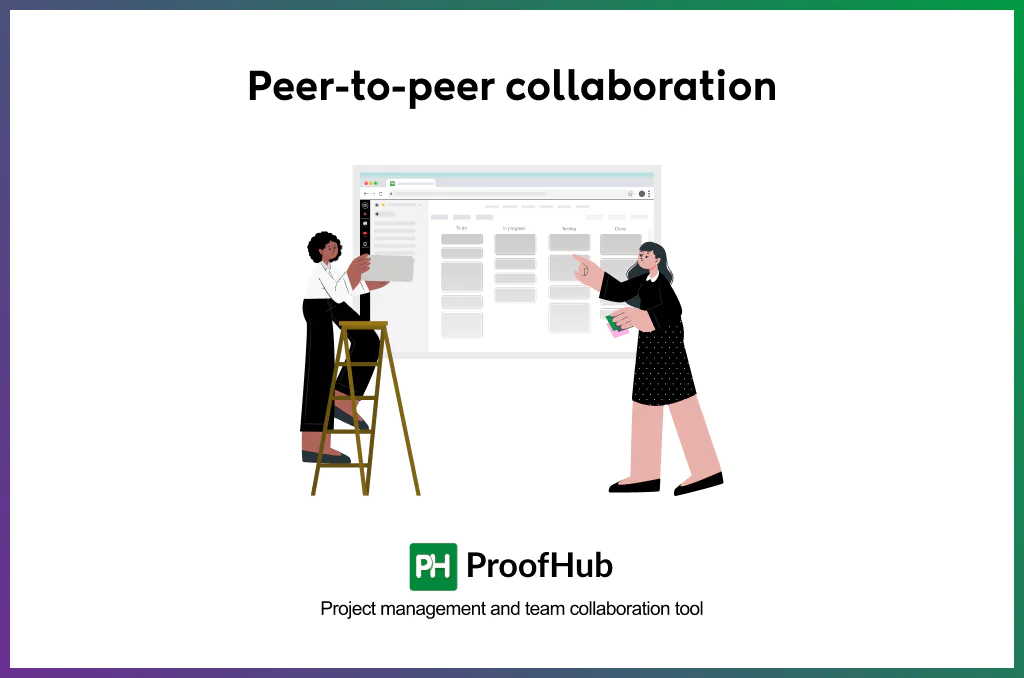
Peer-to-peer (P2P) collaboration is a decentralized method where individuals work together and share resources directly, without a central authority. Instead of a traditional top-down structure, this style emphasize fostering mutual learning and problem-solving without a hierarchical structure.
This collaborative style can positively contribute to the way teams work by enhancing learning, increasing innovation and strengthening employee relationships.
Let’s discuss the benefits in brief:
- Increased innovation: When the team can easily exchange ideas and find solutions, it leads to better results. Having more than one perspective allows team members to build on each other’s ideas. This collaborative approach can lead to more innovative solutions that often don’t occur in a traditional structure.
- Enhanced learning: Peer-to-peer collaboration enables employees to learn directly from each other’s knowledge and experiences. This real-time exchange accelerates learning, builds practical skills, and strengthens the team’s collective expertise.
- Strengthen employee relationships: Direct communication among team members contributes to stronger employee relationships. When the team knows they can trust each other, it also improves a positive work environment, employee morale and overall job satisfaction.
However, implementing a peer-to-peer collaboration style comes with its own set of challenges, such as maintaining direction, building trust and cultivating cultural acceptance.
Let’s discuss the challenges in brief:
- Managing diverse contributions: With diverse inputs from members of different expertise levels, it can be hard to balance participation. Ensuring everyone has a voice without slowing progress is a key challenge.
- Ensuring quality: A variety of contributions may affect consistency and alignment with project goals. Teams must carefully filter ideas to maintain high standards.
- Maintaining direction: Multiple opinions can cause projects to drift away from their original objectives. Leaders need to keep discussions focused while still valuing feedback.
- Cultural resistance: Employees used to hierarchy may see P2P collaboration as chaotic. Building trust in the process takes time and cultural adjustment.
The peer-to-peer collaboration style is ideal for educational and healthcare teams.
4. Hybrid collaboration
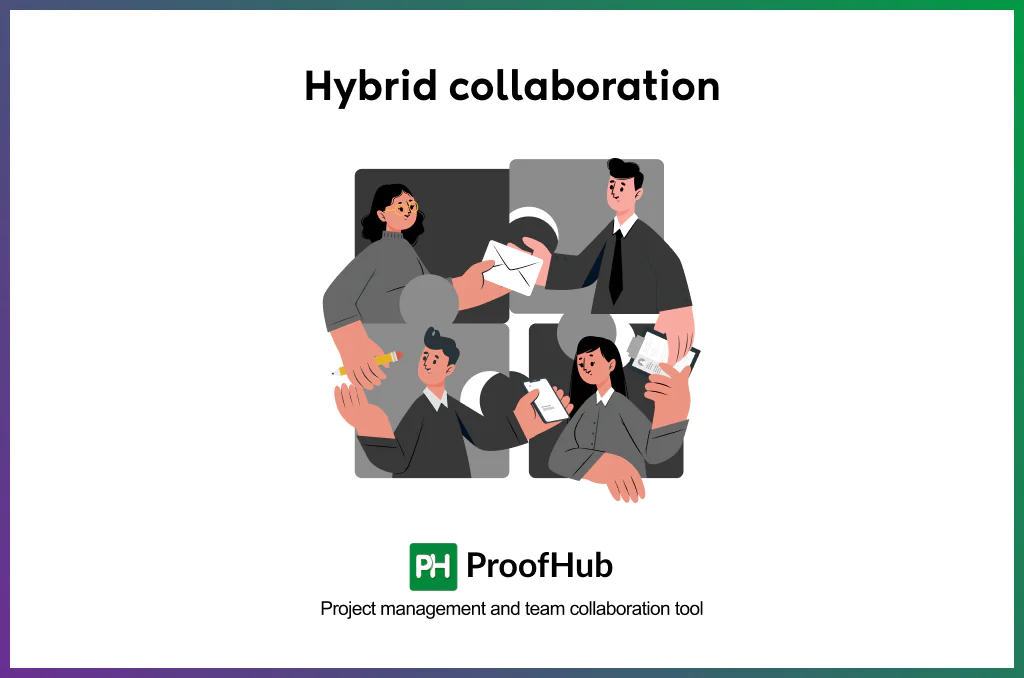
Hybrid collaboration is an approach where some team members work remotely and stay connected with others through collaborative tools to share information. The approach holds value for companies that want to maintain operational efficiency while considering employee’s preferences and geographical constraints.
It saves operational costs, engages employees, and increases talent from different cultural backgrounds.
Let’s discuss the benefits in brief:
- Wider talent pool: Having a hybrid collaboration increases talent as it removes geographical limitations, allowing companies to recruit skilled individuals from any location.
- Operational cost savings: This collaboration style saves on operational costs by reducing office space requirements, decreasing utility bills, and minimizing spending on office supplies, as most people do utilize these resources.
- Higher employee engagement and retention: When a company offers hybrid collaboration options, it significantly increases job satisfaction, employee engagement, and reduces employee turnover.
Along with its benefits, hybrid collaboration also presents some challenges, including technical issues and connecting across different time zones.
Let’s discuss the challenges in brief.
- Technical difficulties: It is one of the major issues when the company has a hybrid collaborative style. Even the smallest difficulty becomes an interpersonal issue with a hybrid team.
- Collaboration hurdles: Collaboration becomes a challenge with different time zones, weak Wi-Fi connections, and poor audio setup. You need to manage the unique requirements of hybrid workspaces.
A hybrid collaboration style is ideal for the tech, finance, and consulting industries.
5. Directive collaboration

A direct collaborative style is a task-oriented approach where the leader takes charge and provides clear guidance and direction to the team members. It is a hybrid style that is effective for time-sensitive tasks and teams that need expertise. It clarifies roles, assigns responsibilities, and establishes clear deadlines, ensuring tasks are completed effectively and goals are met quickly.
This collaboration style is quite beneficial for teams and projects as it is efficient and fast-paced.
Let’s discuss the benefits in brief:
- Efficient: This collaboration style can help teams work more productively and efficiently due to clear instructions and direction. When the team leader sets expectations and assigns responsibilities, teams spend less time discussing and more time in execution. This keeps the project moving forward without any delay.
- Fast-paced: Directive collaboration is fast-paced, as decision-making lies in the hands of leaders. It makes a directive collaboration style effective for projects where every minute counts.
Along with perks, directive collaboration instils inconsistent expectations, increases turnover risks, and reduces morale.
Let’s discuss the challenges in brief:
- Inconsistent expectations: Directive collaboration makes employees confused about their roles and responsibilities, as there is no autonomy among team members. This sends mixed signals and makes them believe that the “Collaborative” portion is just for show, and they lose faith in leadership.
- High turnover risks: This approach leads to high turnover rates as employees become demotivated. They feel their contributions are consistently devalued, and autonomy is restricted.
- Reduced morale and innovation: In a workplace where directive collaboration dominates, employees are less likely to take initiative, find creative solutions, or feel personally invested in the outcome.
- Suitable for simpler tasks: This approach is suitable for simpler tasks as they don’t require step-by-step guidance and brainstorming. It is beneficial for teams with less experience.
The collaborative style is successful for manufacturing and technical teams.
6. Facilitative collaboration

Facilitative collaboration is another style where one person is appointed to guide the team. This designated facilitator leads the team in discussions, making it easier for the team to achieve shared goals. This style ensures that everyone’s voice is heard and promotes an inclusive environment.
This style offers several key advantages that help teams work more effectively. It promotes inclusivity, fosters a supportive environment, and solves problems.
Let’s discuss the benefits in brief:
- Promotes inclusivity: Facilitative collaboration ensures that everyone feels psychologically safe and empowered to contribute to the discussions and decision-making process. The major role of facilitators is to create environments where the team can speak their mind and contribute their ideas for a stronger outcome.
- Fosters a supportive environment: One of the strongest advantages of the facilitative collaboration style is that it helps align the thoughts and contributions of the team in a better way. Also, the team can learn from each other and grow personally and professionally.
- Problem-solving through cognitive intelligence: By combining various areas of expertise into a single problem-solving task, facilitator collaboration increases a team’s cognitive intelligence. Knowledge and reasoning are shared among the group rather than depending on a single viewpoint, enabling concepts to be considered from several perspectives.
However, this approach also presents challenges that can affect its effectiveness. These include the need for a skilled facilitator and maintaining productive discussions.
Let’s discuss the challenges in brief:
- Need a skilled facilitator: You will need a skilled facilitator if you want to make this type of collaborative style work. If this is not the case, the team will not feel comfortable sharing their thoughts, leading to unproductive and unequal power dynamics.
- Unclear decisions: The facilitator allows participants to make their own decisions or draw their own conclusions. It can lead to unclear decisions because of multiple points of view.
This collaboration style is well-suited for product development teams.
7. Cooperative collaboration
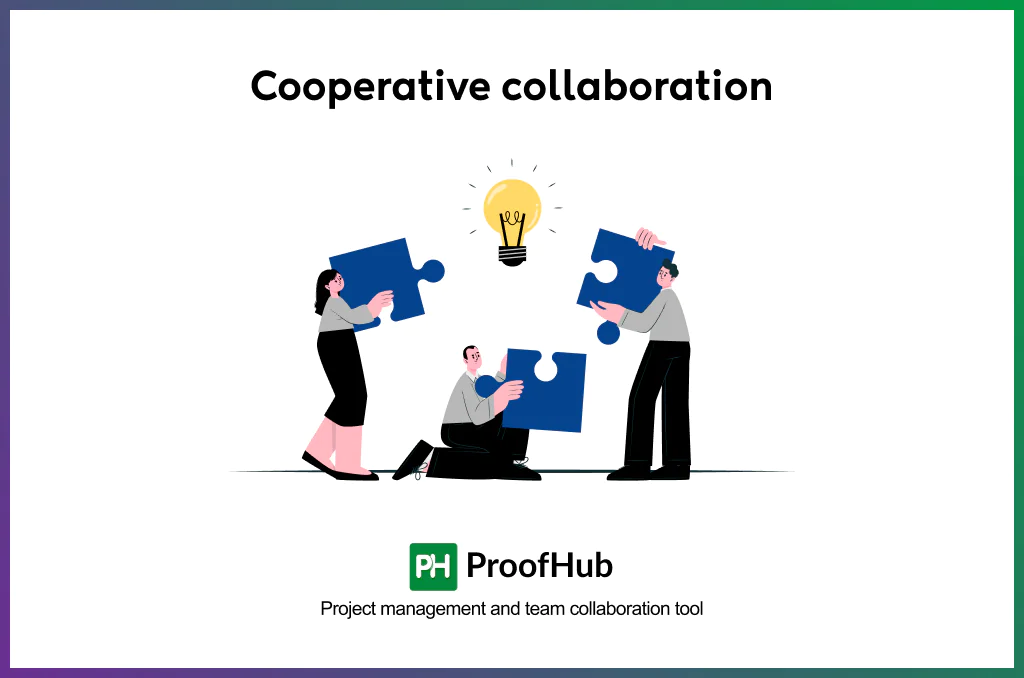
Cooperative collaboration is a team-focused style in which team members share ideas towards a common goal quite openly. In this approach, team members exchange ideas, information, and resources while supporting one another. It results in unimaginable creativity and innovation as diverse strengths of the team are combined towards a shared goal.
This kind of collaboration style offers benefits such as giving shared ownership, fostering trust, and streamlining workflows, which can add value to a workplace.
Let’s discuss the benefits in brief:
- Fostering trust and mutual respect: Cooperative collaboration encourages open communication and idea sharing, which makes the team comfortable sharing theoretical ideas and perspectives. Ultimately, it promotes trust and mutual trust.
- Shared ownership: This collaborative style allows the team to take ownership of a project collectively. It values every team member, their opinion, so the control is not in the hands of one but of everyone. It helps in deciding what is best for you and your team members.
- Streamlined workflows: Cooperative collaboration style helps in improving communication, transparency, automating manual tasks, and reducing bottlenecks. It enables the easy optimization of processes, improves efficiency, and helps teams respond to challenges more quickly.
Along with the perks, the cooperative collaboration approach has some limitations, including a slow process, difficulty in decision-making, and imbalanced work.
Let’s discuss the challenges in brief:
- Slow process: Every person in the team reflects different behaviour. When there is so much information, perspectives, and resistance to change, the decision-making process can slow down.
- Struggling with decision-making: Reaching a consensus is challenging when you have multiple opinions to consider. Sometimes, team members don’t even want to change their minds. It becomes difficult to reach a consensus at this point.
- Exploitation for work: Inbalanced work, unfair recognition, and misaligned goals are the main reasons why some team members have an advantage over others. The unequal power dynamics can further lead to a lack of transparency, and some people doing the work of others.
A cooperative collaboration style is ideal for development and marketing teams.
8. Competitive collaboration
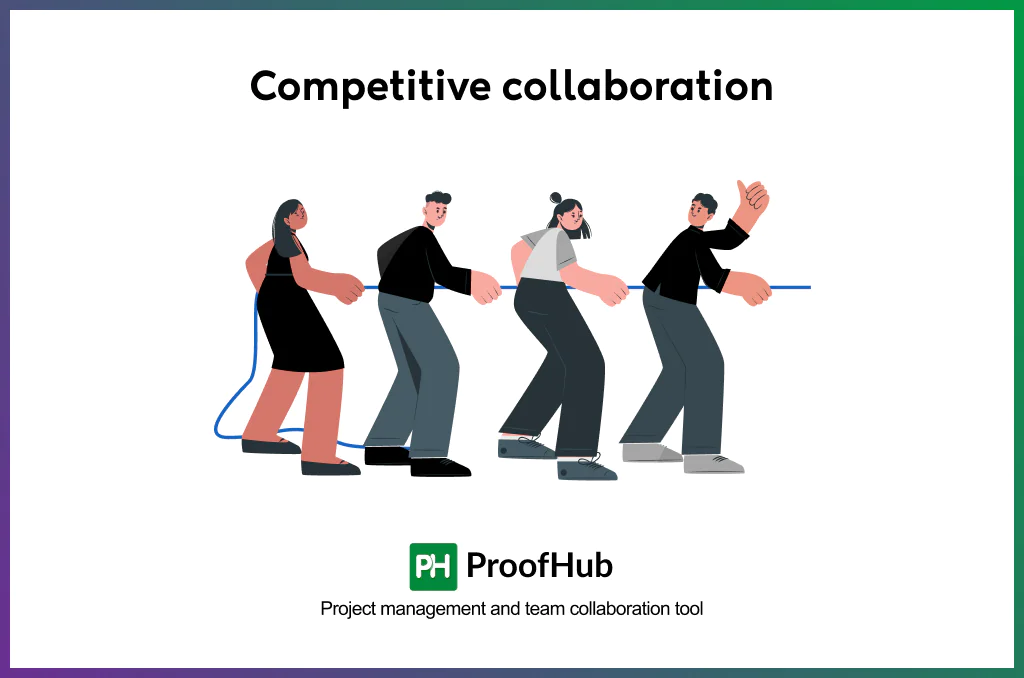
This collaboration style helps you use the competition to drive motivation and excellence in your team. This approach is highly motivating and encourages team members to push their boundaries and become as innovative as they can. With this, your team can find creative solutions to the problems and achieve better results.
This style can encourage individual contributions and increase personal accountability.
Let’s discuss the benefits in brief:
- Encourage individual contributions: It is human nature to perform better than others and perform to the best of their potential. When team members are motivated to outperform each other, they are likely to come up with creative ideas and solutions.
- Personal accountability: Team members become more accountable when they know the team’s success or failure depends on their actions. Team members are encouraged to take ownership of their tasks to achieve common goals and learn from each other’s performance.
Competitive collaboration constitutes several disadvantages as it puts strain on relationships, the quality of work is compromised, and there are chances of inter-team conflicts.
Let’s discuss the challenges in brief:
- Strained relationships: This collaboration style encourages competition among team members, which creates unhealthy rivalries and causes strained relationships. When the major focus of the organizations is on either winning or losing, it will cause resentment and hinder collaboration.
- Compromised quality: When team members compete with each other, they focus on quick results rather than the quality and productivity of the product and service.
- Exclusion of team members: When teams become competitive, it can lead to exclusion through discrimination and bias, resulting in negative consequences such as hindered collaboration and low morale.
- Inter-team conflicts: Because of this competitive style, team members may be more focused on outperforming one another than on working together and sharing ideas, which could lead to more conflicts.
Competitive collaboration is ideal for sales, marketing, or competitive tech development teams.
9. Delegative collaboration

Delegative collaboration is referred to as a collaborative style where team members are given complete ownership of their work, and they can work independently and make their own decisions. It also ensures that the employees are getting support and guidance when needed. However, the leader’s participation is minimal in day-to-day activities.
This style will help you develop individual skills, increase ownership and reduce management overload.
Let’s discuss the benefits in brief:
- Develops individual skills: When team members are given responsibilities, they get to identify their strengths and take on responsibilities for professional growth. This results in improved leadership and decision-making skills.
- Increases autonomy: Empowering team members with significant decision-making authority and freedom to manage their own work with minimal leader interference. This collaboration style increases autonomy, leading to a more engaged and motivated workforce.
- Reduces management workload: By delegating tasks and empowering team members to work autonomously, managers can reduce their own workload and prevent burnout, allowing them to focus on other strategic tasks.
Although delegative collaboration offers benefits, it also has several disadvantages, including a lack of direction, difficulty in crisis management, and uneven workload.
Let’s discuss the challenges in brief:
- Lack of direction and confusion: When the team doesn’t have clear guidance, just the list of tasks they need to complete, they become confused about their roles, responsibilities, priorities, and overall organizational goals, which will make it difficult to align their efforts.
- Difficulty in crisis management: When there is no centralized decision-making, teams struggle to respond effectively during urgent situations.
- Uneven workload and resentment: When work is unfairly distributed, some employees take more responsibility while others underperform. It causes resentment and affects team morale.
This collaborative style is ideal for design, writing, and advertising teams.
10. Introspective collaborators

Introspective collaboration style is identified as a thoughtful and deliberate approach where individuals prefer to generate and develop ideas independently before sharing them with a group. This approach gives individuals the opportunity to think about a topic and conduct their own research.
This approach helps individuals feel comfortable in their work environments, increases self-awareness, and supports their growth.
Let’s discuss the benefits in brief.
- Enhanced communication:
Introspective collaboration fosters an environment where individuals feel comfortable communicating at their own pace, leading to more effective idea exchange and feedback loops, even with diverse personality types.
Increased self-understanding: Introspective collaboration encourages individuals to become more aware of their own strengths and weaknesses within a team setting, leading to better personal and professional development.
Drives growth and competitiveness: By enhancing innovation, problem-solving, and productivity, introspective collaboration helps organizations adapt to change, drive growth, and become more competitive in their industries.
While there are positive aspects, several challenges also exist, including communication barriers, difficulties with shared understanding, and internal competition.
Let’s discuss the challenges in brief:
- Communication barriers: A primary challenge is ensuring clear and open communication. This includes miscommunication, misunderstandings, language differences, and different communication styles among participants.
- Difficulty with shared understanding: It’s hard to ensure everyone is on the same page, especially if there’s a presumption that others have the same background knowledge or perspectives, leading to gaps in understanding.
- Silo mentality and internal competition: A lack of open dialogue and the presence of internal competition can prevent team members from sharing knowledge and working effectively towards a common goal.
An introspective collaboration style is ideal for creative development teams and knowledge-based teams.
11. Relational collaborators
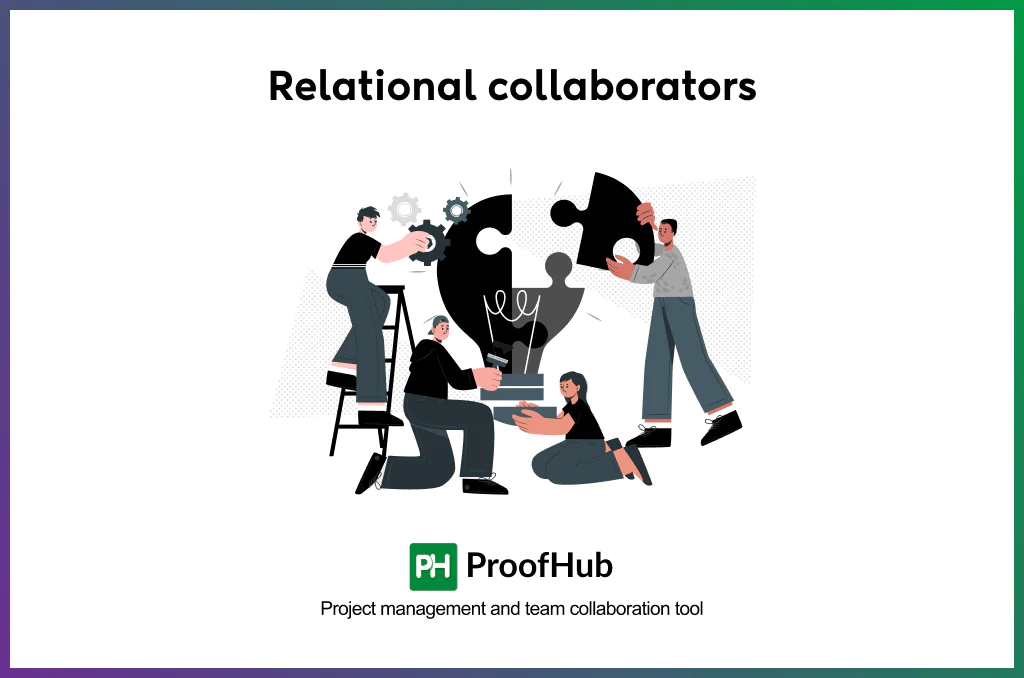
A relational collaboration style, also known as the human-centred collaboration style, emphasizes human connection and interpersonal interaction as the most important aspect of teamwork. Relational collaborators prefer face-to-face or direct human interaction over purely digital collaboration tools, as they value trust and understanding.
The benefits of relational collaboration are immense; they include psychological safety, enhanced problem-solving, and increased engagement.
Let’s discuss the benefits in brief:
- Psychological safety: Strong workplace relationships create a culture of psychological safety, where individuals feel comfortable sharing ideas, concerns, and mistakes without fear of negative repercussions.
- Enhanced problem-solving: By bringing together different viewpoints and expertise, teams can devise more thorough and effective solutions to challenges
- Increased engagement: Feeling valued, supported, and connected to colleagues contributes to higher job satisfaction and greater employee engagement.
However, the drawbacks of relational collaboration involve conflicting priorities, trust building, and cultural differences.
Let’s discuss the challenges in brief:
- Conflicting priorities: Different roles, responsibilities, and goals within partner organizations can create conflicting priorities, leading to delays and disagreements.
- Trust and relationship building: A successful collaboration requires a solid foundation of trust between individuals and organizations, which can be difficult to establish.
- Cultural and value differences: Discrepancies in organizational cultures, values, and leadership styles can create disharmony and tension within the collaboration.
The relational collaboration style is ideal for marketing and design teams.
12. Expressive collaborators
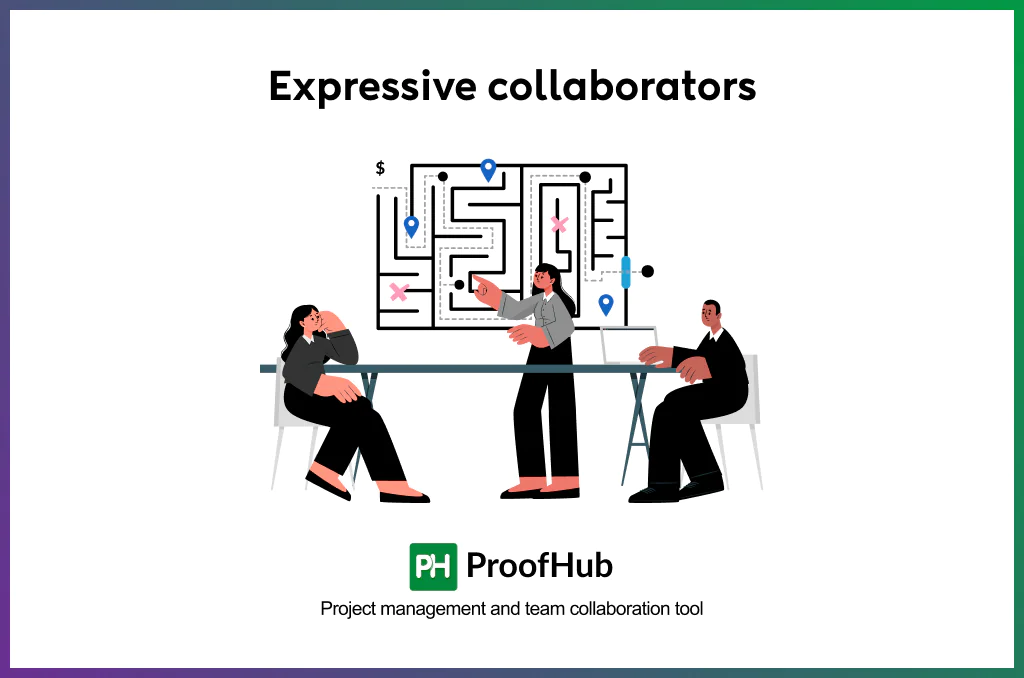
An expressive collaboration style is characterized by being energetic, enthusiastic, and relationship-oriented, with a focus on big ideas, innovation, and engaging with others through visual means and open communication. Expressive collaborators prefer working in teams and enjoy exploring future visions.
This collaborative style offers numerous benefits, including shared workloads, stronger connections, and enhanced brainstorming.
Let’s discuss the benefits in brief:
- Shared workload: Collaboration allows tasks to be divided based on individual strengths, leading to increased efficiency and faster project completion.
- Stronger connections: Working together towards a common goal helps build strong professional relationships and a sense of community within the team, enhancing the employee experience.
- Brainstorming: Collaborative environments provide a natural space for brainstorming and developing creative solutions that might be missed by individuals working alone.
Along with advantages, it has several disadvantages, such as poor flow, resistance to change, and poor leadership.
Let’s discuss the challenges in brief:
- Barriers and poor flow: Miscommunication and a lack of open channels can block information sharing and lead to misunderstandings.
- Resistance to change: Unwillingness to work together or adapt existing methods can kill collaboration.
- Poor leadership: A lack of clear direction or guidance from leadership can lead to confusion and conflict within teams.
An expressive collaboration style is ideal for creative agencies and R&D groups.
What are collaboration styles?
Collaboration styles are different approaches people use while working with a team, which can be categorized by individual preferences (introspective, relational or expressive), or by the structure of the work (peer-to-peer, hybrid, hierarchical, or flat). Key collaboration styles include cooperative, competitive, directive, facilitative, and delegative.
They influence how decisions are made, conflicts are resolved, and how effectively a team can leverage diverse strengths. Understanding these approaches is crucial to improving communication, promoting innovation, and achieving goals.
Why do collaboration styles matter in the workplace?
Collaboration styles determine how teams work together, make decisions, communicate, and approach shared goals. Every organization has a unique structure, culture, and members with different personalities; the right style of collaboration ensures that the differences work together rather than creating friction.
Different styles directly influence how information flows, conflicts are managed, accountability is shared, and teams communicate. When leaders identify and apply the most suitable style, they create an environment that supports clarity, creativity, and efficiency.
A mismatch between organizational structure and collaboration style can lead to misunderstandings, delays, and decreased productivity.
How to identify the right collaboration style for your team?
To identify collaboration style for your team, evaluate your team’s dynamics and the existing organizational structure, communication preferences, and team goals.
Begin by evaluating team dynamics, whether your members thrive on structured or flexible collaboration, and whether decisions are best made collectively or by leadership. Teams that handle creative projects may benefit from a participative and cooperative style, while teams managing technical projects with deadlines may prefer a coordinated or structured style.
Simultaneously, consider your organization’s structure, whether it is a rigid hierarchy with defined workflow or a flat organization that encourages peer-to-peer input.
After that, analyze the team’s goals and needs of the project, whether it requires innovation, strong relationship-building, or productivity. The final step is to discuss with the team to establish team norms and agree on collaborative approaches that align with these factors. The chosen style must be feasible within this existing system to be adopted successfully.
What is the role of leadership in shaping collaboration style?
Leadership defines the systems; they decide the structure, participants, their authorities, and tools. They shape collaboration style by setting the tone, structure, and expectations for how teams work together.
Leaders directly influence whether collaboration feels open and inclusive or structured and hierarchical. Their communication style, decision-making approach, and ability to build trust directly affect how employees interact and share ideas.
A leader who promotes transparency and psychological safety encourages inclusive and creative collaboration, where team members feel valued and confident to contribute. In contrast, a more directive leader may facilitate a structured collaboration style, ensuring clarity, speed, and alignment with organizational goals.
Effective leaders continuously adapt their collaboration style based on the team’s skills, project complexity, and cultural context, ensuring the team remains efficient, interested, and aligned with strategic objectives.
How to transition from one collaboration style to another without disrupting workflow?
To transition from one collaboration style to another without minimal disruption to the workflow, you need to –
- Clearly communicate the reasons
- Plan the change
- Introduce new styles and do test runs
- Provide adequate training and support
- Establish clear communication protocols
- Choose centralized tools
- Gather continuous feedback
You need to change the collaborative style of your workplace to increase productivity, greater adaptability, and improved employee engagement. When the transition happens smoothly, the organization maximize the return on its investment in the new approach.
How do collaboration styles affect innovation and employee satisfaction?
Collaboration styles affect innovation and employee satisfaction by promoting the exchange of ideas, creativity, and diversity of viewpoints. Most effective encouragement styles stimulate innovation and improve problem-solving.
When you foster a feeling of community, enhance communication, strengthen bonds, and lower stress, you raise employee satisfaction, which ultimately raises employee engagement and retention. However, a poorly run collaborative workplace setting can cause conflict and become a hindrance to an organization’s growth.
Can collaboration styles affect decision-making speed?
Yes, collaboration styles can definitely affect decision-making speed. Some styles can increase it by centralizing authority, while others gather diverse ideas but take longer to make decisions, so the teams must balance speed with decision quality.
Can teams combine multiple collaboration styles effectively?
Yes, teams can successfully mix styles using facilitative collaboration for brainstorming and directive approaches for urgent calls, gaining both creativity and focus, and adapting quickly to shifting goals or project demands.
Can collaboration styles be trained or developed intentionally?
Yes, collaboration styles can be developed through training, role-modelling, and clear team norms. It enables team members to intentionally adopt cooperative, directive, or facilitative behaviors as projects evolve and priorities change.






